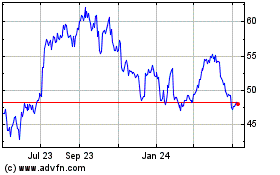As Oil Bust Recedes, Is a Barroom Brawl About to Break Out?
October 21 2016 - 1:00PM
Dow Jones News
By Lynn Cook
The worst of the oil bust may be over, but the energy industry's
infighting has just begun.
Paal Kibsgaard, chief executive of Schlumberger Ltd., the
world's largest oil-field services company and a bellwether for the
sector, told investors Friday that from now on, his company will
only focus on work that is profitable.
It was a shot across the bow of U.S. and international energy
companies, which need Schlumberger and companies like it to help
drill new wells and do hydraulic fracturing, but which have been
paying sharply reduced rates for such services amid the plunge in
oil prices.
In the two years since crude prices plunged from over $100 a
barrel down to around $26 earlier this year, Schlumberger and chief
rival Halliburton Co. drastically reduced the amount that they
charge for equipment and crews to help keep the sector afloat and
the oil flowing. Slashing prices meant working on projects while
losing money and laying off more than 80,000 workers between
them.
Now, oil-field services companies are trying to convince
producers that they need to be paid more if the industry is to
fully recover from the oil bust.
"It's critical for us to recover the large pricing concessions
we have made over the past two years," Mr. Kibsgaard said, adding
that most customers understand this and are willing to
renegotiate.
Earlier this week, Halliburton President Jeff Miller likened the
pricing negotiations that oil-field services firms are having to a
"barroom brawl" with customers.
Executives from Chevron Corp., Anadarko Petroleum Corp. and
other big oil companies have said the wildly high prices charged
during the boom years have to come down and stay down.
Schlumberger reported a 82% drop in its third-quarter profits
Thursday. They fell to $176 million, or 13 cents a share, from $989
million on lower sales and expenses related to its acquisition of
Cameron International Corp. earlier this year.
Halliburton managed to eke out a third-quarter profit of $6
million, or a penny a share, compared with a year-earlier loss of
$54 million, or 6 cents a share, the company reported Wednesday.
Total revenue plunged 31% to $3.83 billion.
Crude prices climbed nearly $25 a barrel in the spring to hit
$50 in early June. The rise prompted many producers to rush back
into the oil patch, particularly the Permian Basin of West Texas,
where half of more than 100 U.S. rigs put back to work in the last
four months have been deployed.
But rising prices for the goods and services needed to tap new
wells is already cutting into what little profitability has
re-emerged in the sector, Mr. Kibsgaard said, adding that it
shrouds how healthy the industry can be in 2017.
For instance, U.S. shale companies are using more sand, mixed in
a slurry of water and chemicals, to stimulate oil and gas wells and
boost output. The result: sand prices are already creeping up.
Halliburton executives told investors earlier this week that
they are essentially taking the loss on more expensive sand for
their clients because they have not yet been able to pass along the
costs. Chief Executive David Lesar said that has to change.
Halliburton has the highest U.S. market share for oil services,
but "if we have to give some back to move margins up we might take
that approach, " Mr. Lesar said in a conference call Wednesday.
Companies like Halliburton and Schlumberger will ultimately
answer the question of whether the downturn-induced pricing
concessions were cyclical and fleeting, or structural and lasting,
said James West, an energy analyst at Evercore ISI.
"It's evident that pricing levels remain 'unsustainable'," he
said.
Write to Lynn Cook at lynn.cook@wsj.com
(END) Dow Jones Newswires
October 21, 2016 12:45 ET (16:45 GMT)
Copyright (c) 2016 Dow Jones & Company, Inc.
Schlumberger (NYSE:SLB)
Historical Stock Chart
From Mar 2024 to Apr 2024

Schlumberger (NYSE:SLB)
Historical Stock Chart
From Apr 2023 to Apr 2024
